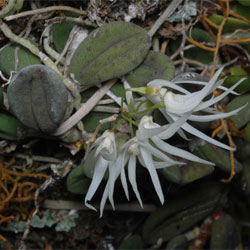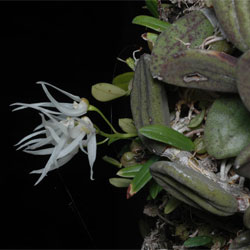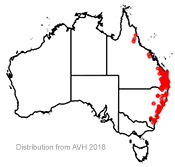Dockrillia linguiformis
 |
 |
Previously known as Dendrobium linguiforme
Tongue Orchid
Dockrillia linguiformis (Sw.) Brieger
 Dockrillia linguiformis, commonly known as the Tongue Orchid, is a hardy orchid, naturally occurring from North Eastern Queensland to South Eastern New South Wales. It grows both epiphytically, on trees, and lithophytically, on rock faces or crevices.
Dockrillia linguiformis, commonly known as the Tongue Orchid, is a hardy orchid, naturally occurring from North Eastern Queensland to South Eastern New South Wales. It grows both epiphytically, on trees, and lithophytically, on rock faces or crevices.
This plant is incredibly easy to cultivate, and will tolerate a wide range of conditions.
Flowers are cream, white or occasionally yellow, with a slightly spidery form, and are produced on inflorescences usually in September and October. An inflorescence can support up to 20 flowers. The leaves are thick and leathery, smooth on the bottom, with several parallel grooves running along the upper surface. The leaves are usually around 2 – 4 x 0.8 – 1.5 cm in size, and are produced alternately from the creeping rhizome.
Within the normal distribution of the plant, it can simply be mounted on a cork slab, tree or rock, and left in a fairly open location, with good air circulation. In fact, the creeping form of the plant makes pot culture almost impossible. In general, the slab should be firm and solid, as the plant doesn’t seem to grow strongly on softer substrates such as tree-fern slabs. While the plant is very tolerant of exposure to sun, high temperatures and low water, it should be sheltered to some extent from frost in cooler areas, either against a wall, or in a sheltered but sunny bush house. In colder areas, glasshouse cultivation may be necessary.
Light daily watering in the morning should be sufficient during the spring and summer, although particularly hot days may merit a second watering, particularly if the leaves start to shrivel and discolour. In the cooler months, watering can be relaxed and less frequent. A slightly drier winter can often improve flowering in the spring. As with many native orchids, overwatering is a common mistake.
Fertiliser shouldn’t be necessary, as the plant, like many epiphytic orchids, normally grows in relatively low nutrient environments. However, small doses of orchid food on a fortnightly or weekly basis may be beneficial in early spring to summer, if heavy flowering is desired.
Propagation for this species is very easy. While growing from seed is very difficult, and usually requires sterile conditions, the creeping form of the orchid makes propagation by cuttings simple. If a short section, with roots and at least four leaves is cut off from the parent plant, and placed on a new slab, it should flourish. Cuttings are best taken in late winter, as new roots will grow in spring, and anchor the plant to its new substrate.
As with all orchids, this species is protected by law and should not be collected from the wild. However, it is usually available from orchid nurseries.
A very similar species is Dockrillia nugentii, which has broader flowers and occurs in northern Queensland.
Text by Richard Brackin (2006 Student Botanical Intern)
Name meaning: Dockrillia linguiformisDockrillia – after Alick Dockrill (1915–2011), an Australian orchidologist linguiformis – from Latin ‘lingua’ (tongue) and ‘formis’ (shaped), referring to the shape of the leaves. |
References
Bishop, Tony (1996) Field guide to the orchids of New South Wales and Victoria. 2nd ed., UNSW Press.
Bedford, Roger B. (1969) A Guide to Native Australian Orchids, Angus and Robertson.
Dockrill, A.W. (1991) Australian Indigenous Orchids, Surrey Beatty and Sons.
Jones, D.L. (1988) Native Orchids of Australia, Reed.
Lavarack, B., Harris, W. and Stocker, G. (2000) Dendrobium and its relatives, Timber Press.
Rentoul, J.L. (1985) Growing Orchids Book Four: The Australian Families, Lothian.
![An Australian Government Initiative [logo]](/images/austgovt_brown_90px.gif)

